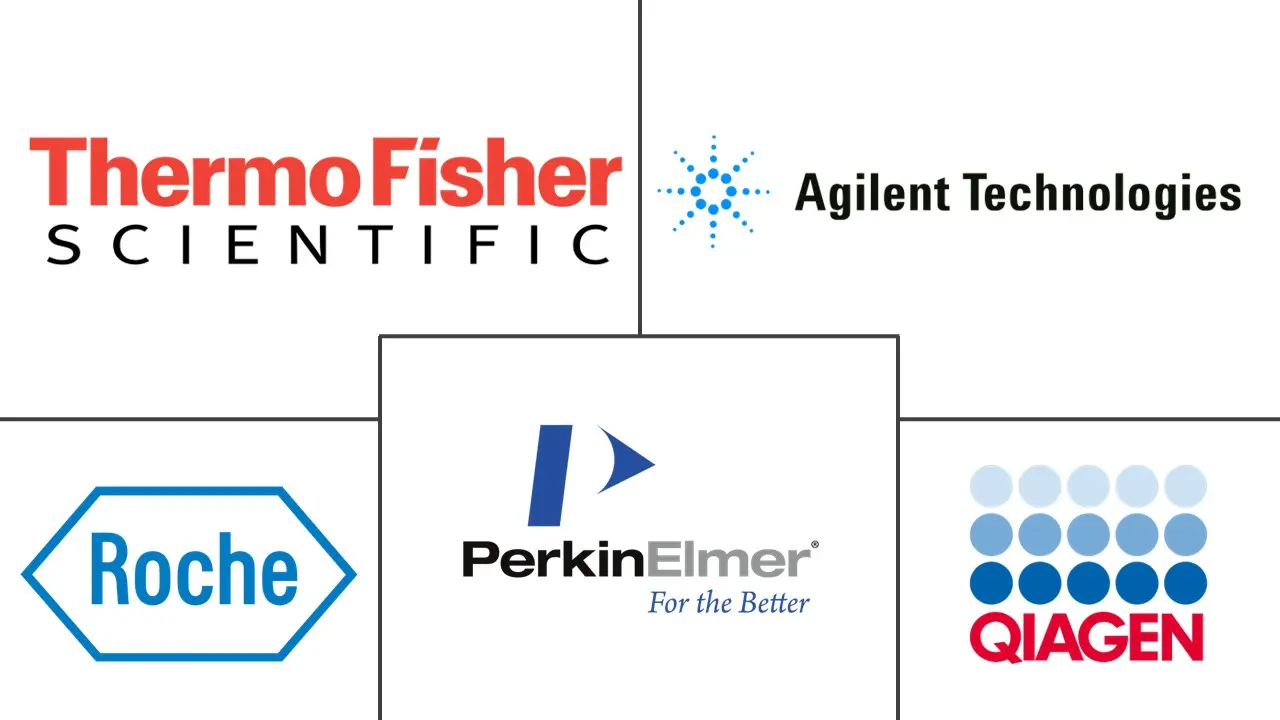Genomics Market Size and Share
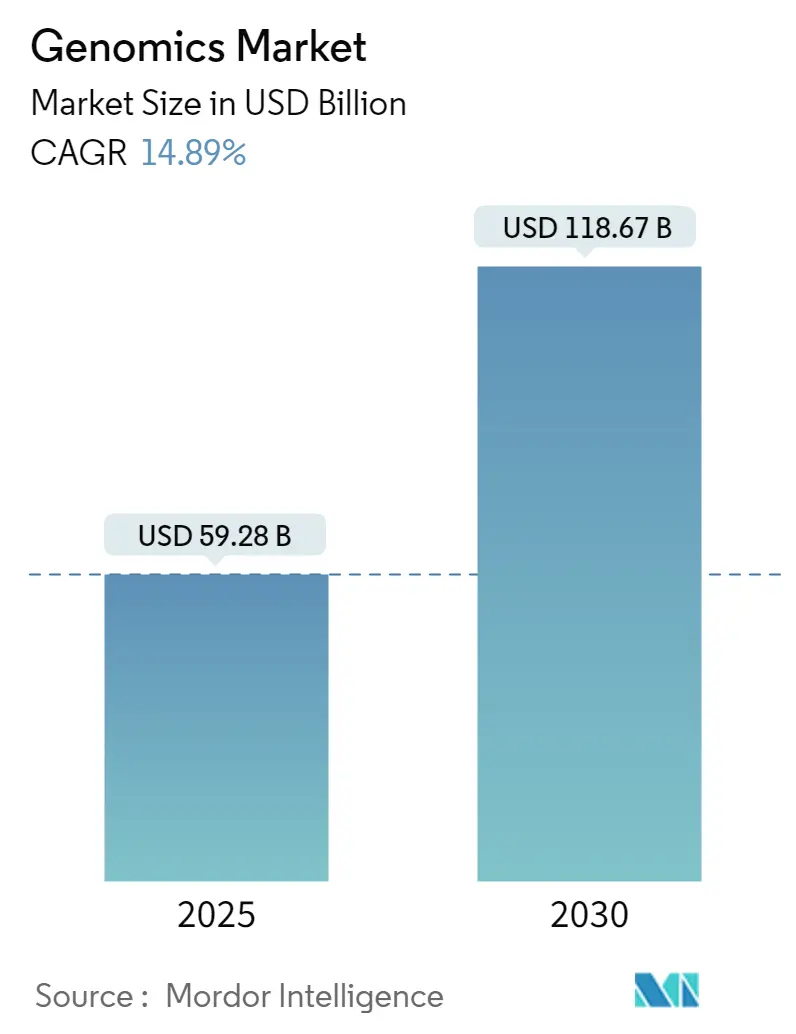
Genomics Market Analysis by Mordor Intelligence
The genomics market is valued at USD 59.28 billion in 2025 and is forecast to double to USD 118.67 billion by 2030, expanding at a CAGR of 14.89%. Declining sequencing costs, population-scale initiatives, and rapid adoption of artificial intelligence position the genomics market for multi-year growth. Sovereign sequencing programs lower per-genome costs toward the USD 200–500 range, while national investments in domestic platforms insulate supply chains and support data sovereignty. Hospitals, pharmaceutical companies, and governments now view genomics as critical healthcare infrastructure rather than an experimental tool, catalyzing spending on instruments, consumables, and cloud analytics. Competitive dynamics continue to tilt toward firms offering integrated hardware-software stacks that reduce turnaround time and support regulatory compliance. Finally, moderated consolidation, anchored by partnerships rather than complete acquisitions, preserves room for innovative entrants that focus on long-read chemistry, AI interpretation, and cloud bioinformatics.
Key Report Takeaways
- By product and services, consumables led with a 43.7% revenue share in 2024, while the services segment is advancing at an 18.2% CAGR through 2030.
- By technology, PCR retained 35.2% of the genomics market share in 2024; sequencing platforms are tracking a 17.5% CAGR to 2030.
- By application, diagnostics captured 38.1% of 2024 revenue; precision medicine is projected to expand at a 20.1% CAGR through 2030.
- By end user, pharmaceutical and biotechnology firms commanded 32.7% share of the genomics market in 2024, whereas hospitals and clinics are growing at 15.9% CAGR.
- Geographically, North America held 42.5% market share in 2024; Asia Pacific is the fastest-growing region at 17.8% CAGR through 2030.
Global Genomics Market Trends and Insights
Drivers Impact Analysis
| Driver | (~) % Impact on CAGR Forecast | Geographic Relevance | Impact Timeline |
|---|---|---|---|
| Population-Scale Newborn Genome Sequencing Programs | +3.20% | Global, with early gains in UK, Singapore, Nordic countries | Medium term (2-4 years) |
| Integration Of Genomic Data With AI-Driven Predictive Health Platforms | +2.80% | North America & EU, expanding to APAC | Short term (≤ 2 years) |
| Long-Read Sequencing Unlocks Epigenomic & Structural Variant Insights | +2.10% | Global, concentrated in research hubs | Medium term (2-4 years) |
| Growing Government Funding & National Genomics Initiatives | +2.40% | APAC core, spill-over to MEA | Long term (≥ 4 years) |
| Rapid Cost Decline Of NGS & Ancillary Technologies | +2.90% | Global | Short term (≤ 2 years) |
| Expanding Clinical & Research Applications Across Precision Medicine | +3.10% | North America & EU, expanding globally | Medium term (2-4 years) |
| Source: Mordor Intelligence | |||
Population-Scale Newborn Genome Sequencing Programs
National health systems are adopting universal newborn genome sequencing to shift pediatric care from reactive to predictive. The UK NHS is scaling whole-genome screening, while Singapore’s program targets familial hypercholesterolemia. Such initiatives lock in long-term reagent demand for high-throughput sequencers and generate datasets that pharmaceutical companies license for orphan-drug discovery. Analysts project a 10-to-1 economic return from avoided late-stage treatments, reinforcing sustained public funding. Implementation challenges, such as genetic-counselor shortages and secure data storage, drive hospitals toward cloud bioinformatics platforms.
Integration Of Genomic Data With AI-Driven Predictive Health Platforms
Artificial intelligence turns genomic outputs into longitudinal risk scores and treatment recommendations. Illumina’s collaboration with NVIDIA demonstrates how GPU-accelerated algorithms cut secondary-analysis time and improve variant calling precision. US health systems report 30% fewer adverse drug reactions after adding AI-guided pharmacogenomics, while drug makers use multiomic AI to stratify trial populations.[1]Philip Payne, “Cancer mortality drops with genome-matched therapy,” Nature, nature.comFirms fluent in both FDA device regulations and emerging AI governance are winning hospital contracts. Heightened privacy expectations are pushing vendors to adopt homomorphic encryption and federated learning.
Long-Read Sequencing Unlocks Epigenomic & Structural Variant Insights
Long-read chemistries from Oxford Nanopore and Roche resolve telomere-to-telomere assemblies, detect large rearrangements, and measure methylation in a single run. Clinical labs report 25% higher diagnostic yields in rare-disease and oncology workflows. This capability expands demand for computational storage and updates to existing short-read bioinformatics pipelines. Cost parity with short-read systems is approaching, further accelerating adoption in tertiary care centers and academic hospitals.
Growing Government Funding & National Genomics Initiatives
Governments see genomics as a strategic infrastructure. The UK earmarked GBP 650 million for population genomics, and several Asian economies are mapping national cohorts to fuel domestic biotechnology. Public-private consortia are building sovereign cloud platforms, local reagent manufacturing, and training pipelines for bioinformaticians. Procurement preferences favor domestic suppliers, reshaping regional competitive landscapes and prompting multinational vendors to establish in-country production.
Restraints Impact Analysis
| Restraint | (~) % Impact on CAGR Forecast | Geographic Relevance | Impact Timeline |
| Data-Sovereignty Rules Limiting Cross-Border Sample/Data Flows | -1.80% | EU, China, emerging markets with data localization requirements | Long term (≥ 4 years) |
| Consumer-Genomics Backlash Eroding Public Trust & Sample Supply | -1.20% | North America, EU markets with privacy concerns | Medium term (2-4 years) |
| Persistent High Capital Cost Of Advanced Sequencers & Reagents | -1.10% | Global, particularly affecting smaller laboratories and emerging markets | Medium term (2-4 years) |
| Shortage Of Skilled Bioinformaticians/Genomic Counselors | -0.90% | Global, with acute shortages in APAC and emerging markets | Long term (≥ 4 years |
| Source: Mordor Intelligence | |||
Data-Sovereignty Rules Limiting Cross-Border Sample/Data Flows
The European Health Data Space and China’s biosecurity legislation place strict controls on genomic transfers, forcing multinational providers to establish regional data centers and compliant workflows. These parallel infrastructures raise operating costs, slow collaboration, and favor domestically integrated competitors. Smaller firms lack regulatory bandwidth risk exit or acquisition, reinforcing consolidation among globally diversified players.
Consumer-Genomics Backlash Eroding Public Trust & Sample Supply
Several high-profile breaches and the distressed sale of 23andMe to Regeneron for USD 256 million have shaken consumer confidence. Participation in direct-to-consumer testing programs is falling, which reduces the inflow of samples and biases population datasets. Health systems observe higher patient refusal rates despite physician recommendations, slowing clinical adoption. Vendors are responding with stronger encryption and transparent opt-in models, but rebuilding trust is a multi-year endeavor.
Segment Analysis
By Product & Services: Consumables Drive Market Foundation
Consumables delivered 43.7% of 2024 revenue, underscoring their essential role in daily sequencing workflows. Growth is supported by kit standardization that minimizes batch variability and by automation that speeds library preparation. The services category, supported by sequencing-as-a-service and bioinformatics outsourcing, is expanding at an 18.2% CAGR as laboratories convert capital outlays into operating budgets. Instrument demand remains steady because mid-life upgrades and long-read adoption offset hospital capital constraints. Software & informatics, once an accessory, now attracts premium spend as data interpretation becomes the primary bottleneck. Vendors bundle reagent subscriptions with AI-powered analytics and support contracts, securing predictable revenue and higher customer retention.
Consumable purchasing is no longer limited to core reagents. Labs order specialized extraction kits for challenging samples, CRISPR gene-editing consumables for functional assays, and barcoded microplates for high-throughput studies. Service providers add value with CLIA-certified testing, insurance billing, and cloud portals that deliver physician-ready reports. Hospitals gravitate toward these models to accelerate turnaround time without expanding in-house bioinformatics staff. The genomics market benefits because every incremental test pulls through consumables, software, and data-storage needs.
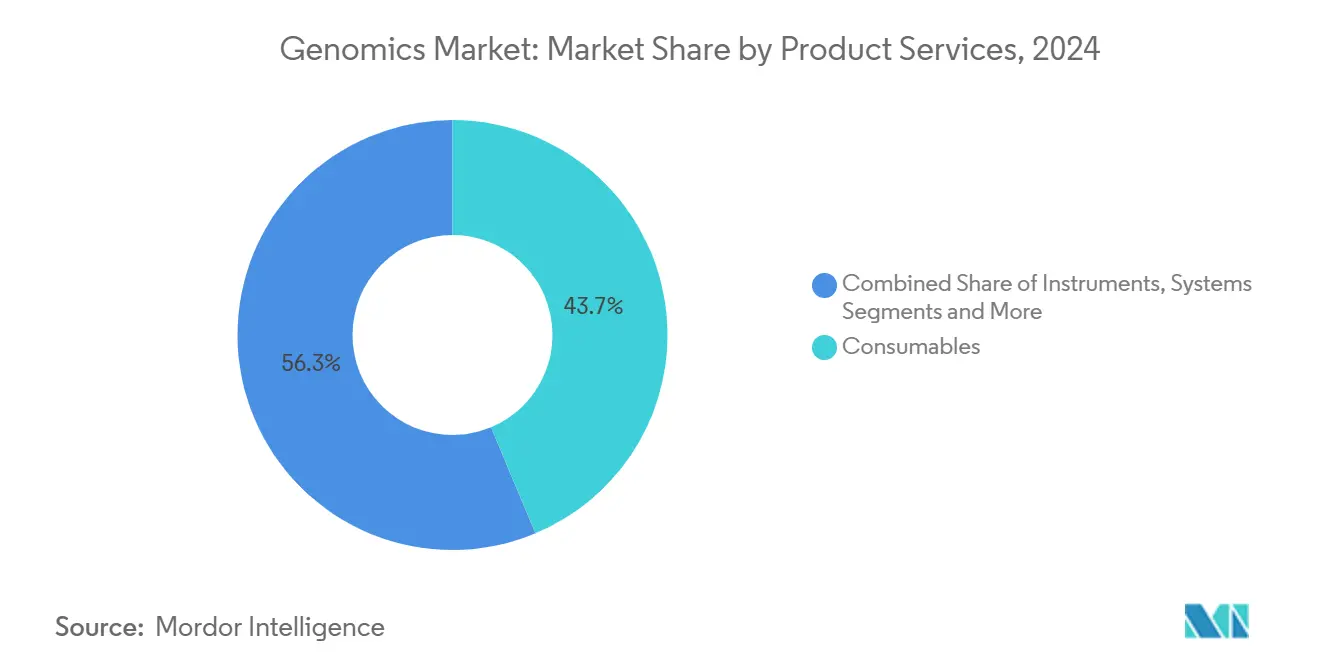
Note: Segment shares of all individual segments available upon report purchase
By Technology: Sequencing Disrupts Traditional Methods
PCR still accounts for 35.2% of 2024 revenue because it delivers speed and low cost in targeted diagnostics and pathogen detection. Yet, sequencing platforms are expanding at 17.5% CAGR as comprehensive genomic profiling becomes feasible in routine care. Long-read and single-molecule systems detect structural variants and methylation states in one pass, closing clinical gaps left by short-read methods. Meanwhile, microarrays continue to lose ground but remain useful for high-volume genotyping.
Sequencing vendors are diversifying chemistries. Oxford Nanopore offers adaptive sampling that selects regions of interest on the fly. Roche is preparing nanopore-based SBX systems that promise higher speed and accuracy by 2026. As long-read accuracy rises and reagent costs fall, laboratories can consolidate multiple assays into a single workflow, reducing hands-on time and overall spending. PCR retains value in decentralized and point-of-care applications where instruments must be rugged, cheap, and fast.
By Application: Precision Medicine Accelerates Clinical Adoption
Diagnostics held a 38.1% revenue share in 2024, reflecting widespread use in oncology, infectious disease, and carrier screening. Precision medicine deployments, however, are growing at 20.1% CAGR as hospitals adopt genomic insights to guide therapy selection across oncology, cardiology, and psychiatry. Drug developers use whole-genome datasets to refine trial inclusion criteria, improving statistical power and approving treatments faster. Agriculture and animal genomics leverage the same platforms for crop development and herd health monitoring.[2]Philip Payne, “Cancer mortality drops with genome-matched therapy,” Nature, nature.com
Clinical evidence is mounting. The Maine Cancer Genomics Initiative recorded 31% lower mortality when treatment matched tumor genomes. Hospitals such as Mass General Brigham have embedded DPYD pharmacogenetic tests into prescribing systems, preventing fluoropyrimidine toxicity. These successes accelerate reimbursement coverage, which in turn fuels broader adoption. Consumer ancestry testing is plateauing, but research and environmental applications offset the slowdown by opening new revenue streams.
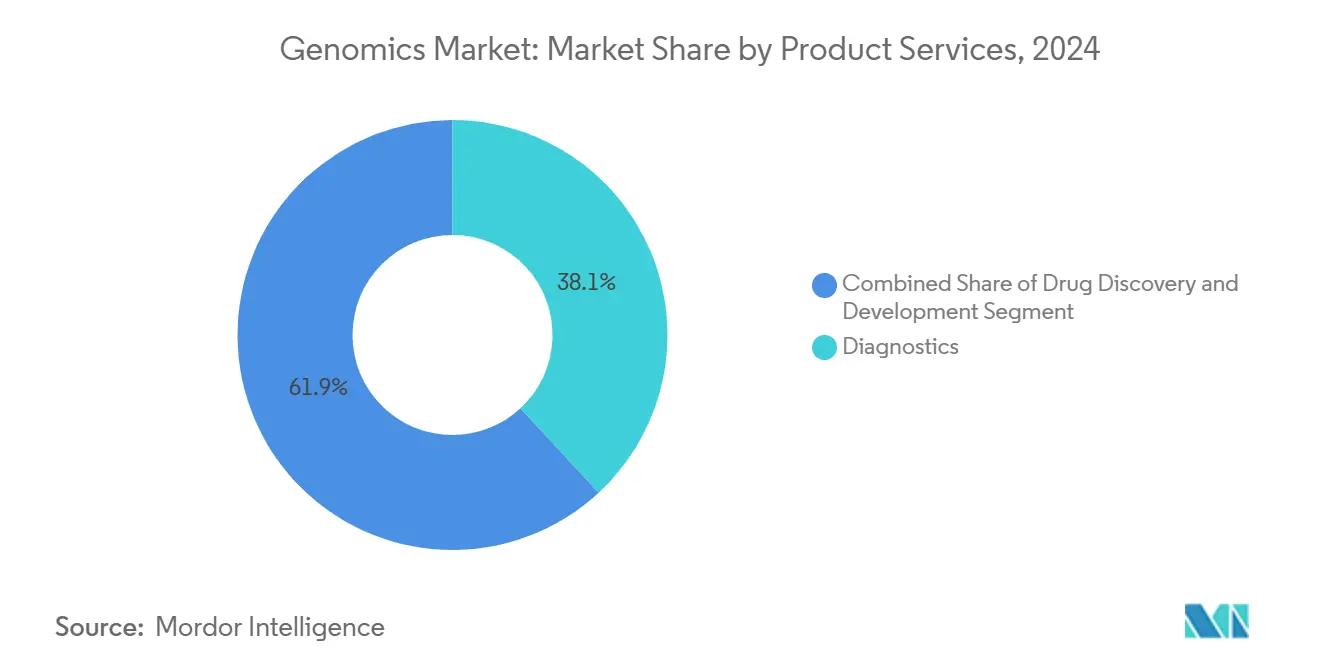
Note: Segment shares of all individual segments available upon report purchase
By End User: Healthcare Systems Drive Clinical Integration
Pharmaceutical and biotechnology companies represented 32.7% of end-user demand in 2024, capitalizing on genomic insights for biomarker discovery and companion diagnostics. Hospitals and clinics are scaling at a 15.9% CAGR as genomic testing becomes routine in oncology, rare disease, and drug-gene interaction management. Diagnostic reference labs experience margin pressure and are consolidating to capture scale efficiencies. Research institutes continue to invest in population studies, while agricultural research bodies and forensic labs provide steady niche demand.
The genomics market shift toward clinical environments forces suppliers to deliver FDA-cleared, CE-marked, and HIPAA-compliant solutions. Illumina noted that clinical revenue overtook research sales in 2023, a milestone that signals lasting change in procurement priorities. End users now evaluate turnkey solutions that integrate sample prep, sequencing, AI interpretation, and electronic health-record reporting. Vendors with service teams that can train physicians and ensure reimbursement approval are earning long-term contracts.
Geography Analysis
North America held 42.5% of global revenue in 2024, supported by advanced reimbursement, large biopharma pipelines, and mature clinical genomics programs. The United States drives most spending through national cohort projects and aggressive hospital rollouts. Canada supports genomics with federal precision health grants, while Mexico collaborates cross-border to modernize diagnostic capacity. Regional headwinds include complex LDT regulations and shortages of bioinformaticians, which slow laboratory expansion.
Europe retains a strong installed base thanks to government-funded population programs and harmonized regulatory pathways. The European Health Data Space eases cross-border research once data-protection criteria are met, encouraging academic-industry partnerships. The United Kingdom’s GBP 650 million commitment and universal newborn genome screening cement long-term demand. Germany and France scale clinical genomics through national insurance coverage, while Southern European countries leverage EU grants to catch up.
Asia Pacific is the fastest-growing region at a 17.8% CAGR to 2030, propelled by China’s self-reliance strategy, Japan’s precision medicine reimbursement codes, and South Korea’s AI-genomics clusters. BGI Genomics expands tuberculosis sequencing and oncology panels that meet domestic data-localization rules. India commercializes low-cost sequencing services for its expanding middle class, and Australia translates research strength into clinical adoption. Government mandates that keep data inside national borders incentivize local manufacturing and create regional winners.
Latin America, the Middle East, and Africa contribute smaller but rising shares. Brazil’s USD 3.4 billion in healthcare M&A and genomic studies on African-Brazilian populations underline interest in diverse cohort research.[3]Dylan Petersen, “Brazil invests USD 3.4 billion in health M&A,” Journal of the American Heart Association, ahajournals.org Gulf states are investing in national precision health initiatives, often partnering with Western technology vendors to fast-track clinical readiness. African nations participate in consortium projects that build sequencing hubs and bioinformatics training, ensuring the genomics market eventually becomes more inclusive.
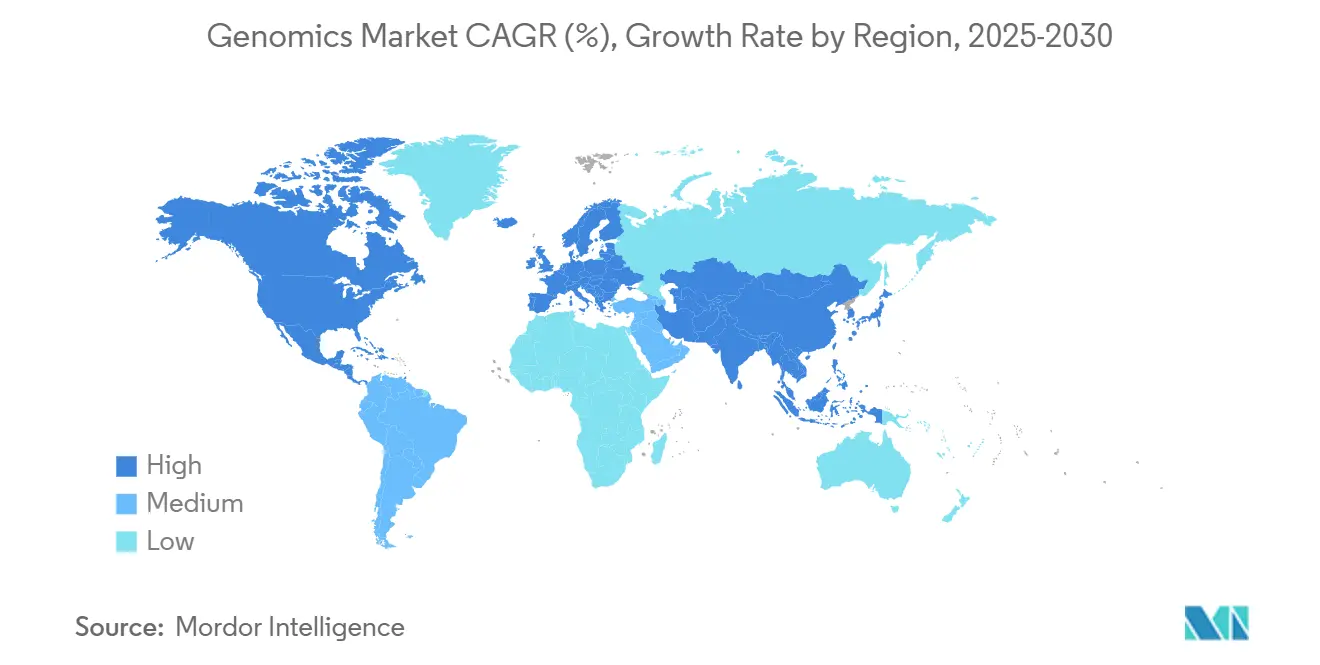
Competitive Landscape
Market consolidation is moderate. Illumina, Thermo Fisher Scientific, and QIAGEN maintain broad portfolios, regulatory track records, and global distribution. Oxford Nanopore and BGI Genomics leverage differentiated chemistry and regional policy support to gain share. Strategic alliances trump mega-mergers; companies pool AI, reagent, and cloud resources to sidestep antitrust risk and focus on rapid product cycles. White-space areas such as spatial omics, single-cell sequencing, and epigenetic profiling attract venture-backed entrants that partner instead of competing head-to-head.
Technology convergence blurs lines between sequencing, software, and laboratory automation. GeneDx bought Fabric Genomics for USD 33 million, adding AI interpretation to its clinical-testing suite. Quest Diagnostics links Google Cloud’s generative AI with its sample network to streamline reporting. Patent disputes, including Illumina’s clash with Molecular Loop over NGS enrichment, underscore the importance of IP positioning. Cost-focused disruptors like Ultima Genomics and Element Biosciences chase the USD 100 genome, pressuring incumbents to accelerate innovation.
Large players sharpen service depth rather than footprint size. Illumina’s TruSight Oncology 500 v2 promises faster, more accurate variant calls, aligning with hospital needs for same-week results. QIAGEN extends Ingenuity Pathway Analysis with AI to automate biological insight extraction. BGI Genomics rolls out PTseq for rapid tuberculosis resistance testing in resource-limited settings. Together these moves illustrate how differentiation now hinges on workflow speed, interpretation accuracy, and regulatory compliance rather than raw throughput.
Genomics Industry Leaders
-
Thermo Fisher Scientific
-
Agilent Technologies
-
F. Hoffmann-La Roche Ltd
-
PerkinElmer Inc.
-
QIAGEN N.V.
- *Disclaimer: Major Players sorted in no particular order
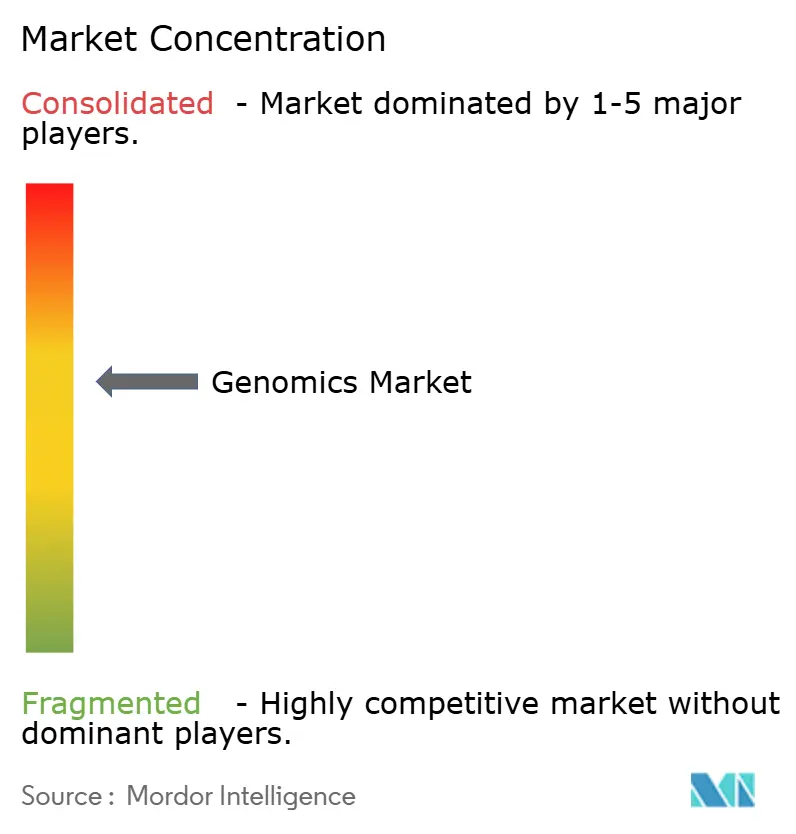
Recent Industry Developments
- April 2025: GeneDx acquired Fabric Genomics for USD 33 million to embed AI-powered interpretation into clinical sequencing workflows.
- April 2025: Illumina expanded its TruSight Oncology portfolio with TSO 500 v2 for faster, more accurate, comprehensive genomic profiling.
- January 2025: Regeneron Pharmaceuticals acquired 23andMe for USD 256 million through bankruptcy proceedings, securing access to genetic data from around 15 million individuals to support drug-discovery pipelines.
- January 2025: Illumina partnered with NVIDIA to integrate GPU-accelerated AI into sequencing platforms, enhancing multiomic analysis.
Research Methodology Framework and Report Scope
Market Definitions and Key Coverage
Our study defines the genomics market as the total revenue generated worldwide from consumables, instruments, software, and associated laboratory or analytical services used to sequence, map, edit, or interpret complete genomes across human, animal, plant, and microbial samples. We treat ancillary bioinformatics modules only when they are bundled with a genomic analysis workflow.
Scope Exclusion: we do not include standalone genetic counseling fees or purely cloud-based data-storage subscriptions that are sold without sequencing or wet-lab analysis components.
Segmentation Overview
- By Product & Services
- Consumables
- Reagents
- Kits
- Microplates
- Instruments & Systems
- NGS Platforms
- PCR Machines
- Microarray Scanners
- Software & Informatics
- Analysis Suites
- LIMS
- AI Decision Support
- Services
- Sequencing-As-A-Service
- Data Analysis
- Consulting
- Consumables
- By Technology
- Polymerase Chain Reaction (PCR)
- Sequencing
- Long-Read/Single-Molecule Sequencing
- Microarray
- Nucleic Acid Extraction & Purification
- Other Techniques
- By Application
- Diagnostics
- Drug Discovery & Development
- Precision/Personalized Medicine
- Agriculture & Animal Genomics
- Forensics & Ancestry
- Other Applications
- By End User
- Hospitals & Clinics
- Diagnostic & Reference Laboratories
- Research Institutes & Centers
- Pharmaceutical & Biotechnology Companies
- Other End Users
- By Geography
- North America
- United States
- Canada
- Mexico
- Europe
- Germany
- United Kingdom
- France
- Italy
- Spain
- Rest of Europe
- Asia Pacific
- China
- Japan
- India
- South Korea
- Australia
- Rest of Asia Pacific
- Middle East and Africa
- GCC
- South Africa
- Rest of Middle East and Africa
- South America
- Brazil
- Argentina
- Rest of South America
- North America
Detailed Research Methodology and Data Validation
Primary Research
We interviewed clinical geneticists, sequencing-platform product managers, lab procurement heads, and reimbursement specialists across North America, Europe, Asia-Pacific, and the Gulf region. These discussions helped us validate average run capacities, reagent refill cycles, service pricing spreads, and, crucially, future purchasing intentions that are not visible in public disclosures.
Desk Research
We begin with tier-one public datasets such as the National Human Genome Research Institute funding tracker, World Health Organization cancer registries, OECD Health Statistics, and customs shipment codes that flag next-generation sequencers; these establish baseline demand signals. We also mine patent families through Questel, review device clearances posted by the US FDA and the European Medicines Agency, and screen peer-reviewed studies archived on PubMed for technology adoption curves.
Our analysts then cross-check trade association updates (Genome Canada, European Biotechnology Association), company 10-Ks accessed via D&B Hoovers, and news flows aggregated in Dow Jones Factiva to sense check pricing shifts and expansion announcements before numbers reach the model. This list is illustrative; many other open and paid sources guided evidence gathering, validation, and clarification.
Market-Sizing & Forecasting
We rebuild the market top-down, starting with installed sequencer counts, reported run throughput (gigabases), and average price per human whole-genome equivalent, which are then multiplied to derive a demand pool; results are corroborated with supplier roll-ups of sampled ASP × volume and channel checks. Key variables include the number of reimbursed genomic tests per 1,000 population, government program spending on large-scale sequencing, average consumable cost per gigabase, share of clinical versus research runs, and annual launches of high-throughput platforms. A multivariate regression on these drivers produces the base forecast, while scenario analysis adjusts for regulatory or reimbursement shocks. Any bottom-up gaps, such as private lab volumes in emerging economies, are bridged with weighted regional proxies agreed during expert calls.
Data Validation & Update Cycle
We pass every quarterly refresh through variance and anomaly screens, compare outputs with external shipment tallies and funding releases, and then route the workbook for a two-step peer review before sign-off. Reports refresh once a year, with an interim update triggered by material events like a disruptive platform launch or a new national genome initiative.
Why Mordor's Genomics Baseline Inspires Confidence
We recognize that published estimates often diverge because firms frame genomics differently, pick varying base years, or lock in currency assumptions at dissimilar dates.
Key gap drivers include narrower product-only scopes, optimistic ASP inflation, or slower refresh cadences. Mordor's model captures services alongside products, refreshes annually, and converts revenues at contemporaneous exchange rates, so clients receive a balanced and current baseline.
Benchmark comparison
| Market Size | Anonymized source | Primary gap driver |
|---|---|---|
| USD 59.28 B (2025) | Mordor Intelligence | - |
| USD 37.89 B (2024) | Global Consultancy A | Excludes services and relies mainly on public company filings |
| USD 42.60 B (2024) | Market Data Firm B | Counts products only and applies one uniform price uplift across regions |
| USD 30.75 B (2024) | Industry Analyst C | Uses prior-year currency averages and omits new diagnostic uptake rates |
We believe the comparison shows that our disciplined scope choices, multi-source variable set, and timely updates deliver the most dependable baseline for strategic planning.
Key Questions Answered in the Report
How big is the Genomics Market?
The Genomics Market size is expected to reach USD 59.28 billion in 2025 and grow at a CAGR of 14.89% to reach USD 118.67 billion by 2030.
What is the current Genomics Market size?
In 2025, the Genomics Market size is expected to reach USD 59.28 billion.
Which is the fastest growing region in Genomics Market?
Asia Pacific is estimated to grow at the highest CAGR over the forecast period (2025-2030).
Which region has the biggest share in Genomics Market?
In 2025, the North America accounts for the largest market share in Genomics Market.
What years does this Genomics Market cover, and what was the market size in 2024?
In 2024, the Genomics Market size was estimated at USD 50.45 billion. The report covers the Genomics Market historical market size for years: 2019, 2020, 2021, 2022, 2023 and 2024. The report also forecasts the Genomics Market size for years: 2025, 2026, 2027, 2028, 2029 and 2030.
Page last updated on:
